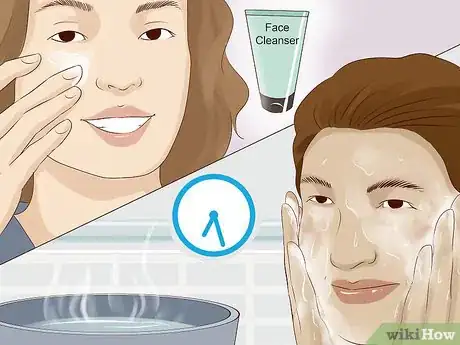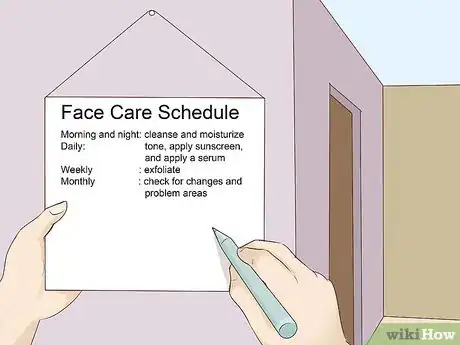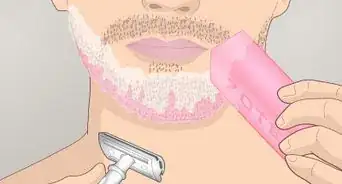This article was co-authored by Mohiba Tareen, MD. Mohiba Tareen is a board certified Dermatologist and the founder of Tareen Dermatology located in Roseville, Maplewood and Faribault, Minnesota. Dr. Tareen completed medical school at the University of Michigan in Ann Arbor, where she was inducted into the prestigious Alpha Omega Alpha honor society. While a dermatology resident at Columbia University in New York City, she won the Conrad Stritzler award of the New York Dermatologic Society and was published in The New England Journal of Medicine. Dr. Tareen then completed a procedural fellowship which focused on dermatologic surgery, laser, and cosmetic dermatology.
There are 10 references cited in this article, which can be found at the bottom of the page.
This article has been viewed 342,762 times.
Taking care of your face is important for the health of your skin. Getting into a good routine is a great way to ensure your face gets the attention and care it deserves, and that you don’t miss any steps along the way. Developing your daily, weekly, and monthly routine starts with figuring out what kind of skin you have, and what your face care needs are.
Steps
Determining Your Skin Care Needs
-
1Figure out your skin type. The four major skin types are normal, oily, dry, and combination. Each of these different skin types has different face care needs, and using products formulated for your type will improve the health of your skin.
- Normal skin may get a bit oily in the T-zone (the area covering your chin, nose, and forehead, in the summer) but doesn’t really get dry and rough.
- Oily skin is characterized by oil production and large pores all over your face.
- Dry skin often feels tight and rough because of lack of moisture, gets flaky in winter, feels itchy after swimming or showering, and is accompanied by small pores.
- Combination skin is similar to normal skin in that there will be some oil production, but you'll also have large pores in the T-zone.[1]
-
2Understand your needs if you have normal skin. People with normal skin tend to have the easiest time caring for their faces. The main thing to remember is to avoid toners that have alcohol, which can dry your skin. Ingredients to avoid include:[2]
- Isopropyl alcohol
- Denatured alcohol
- Ethanol
- SD alcohol 40
Advertisement -
3Know how to address oily skin. The big challenge with oily skin is excessive oil. Many people often use products that strip oil from the skin, but this leaves your face dry and leads to more oil production.[3] Light moisturization is what you're going for instead:
- Wash your face with a dissolving or gel cleanser at least twice daily[4]
- Use an alcohol-free toner that contains sodium PCA and witch hazel
- Use an oil-free moisturizer that contains glycerin
- Go for a zinc-based sunscreen
- When it comes to serums, try an AHA, BHA, or retinol serum that will reduce the appearance of pores
-
4Learn to care for combination skin. Combination skin can be a problem to care for because some areas will be dry while others will be oily. Essentially, use the same face care products as you would if you had oily skin, with the exception of the moisturizer. Instead of an oil-free moisturizer, opt for a lightweight one.[5]
- Many lightweight moisturizers will have the words “lightweight” or “light” on the label.
-
5Understand the needs of dry skin. Dry skin is very sensitive to products, so it’s important to use the right ones. The key with dry skin is to avoid anything that could dry your face further, and to use products that will add moisture back to your skin:
- Use a mild cleanser that doesn’t foam or lather
- Avoid all products, especially toners, that contain alcohol
- Use a hydrating moisturizer with a thicker consistency that contains sweet almond, jojoba, evening primrose, or borage oil
- Try an antioxidant serum that has vitamins A, C, and E[6]
Taking Care of Your Face
-
1Start each morning by cleansing your skin. Wet your face with warm water. Apply a dime-sized dollop of cleanser to your fingers and apply the cleanser to your face. Rub in a circular motion for 30 seconds. Use your hands to rinse the cleanser from your face. Pat your skin dry with an absorbent towel.
- Use warm water instead of hot, as hot water can lead to natural oils on your skin being stripped away.[7]
- Do not rub or scrub your skin when you dry it, as this can cause damage and irritation.
-
2Apply toner after washing your face in the morning. Once your face is clean and dry, soak a cotton ball or pad with toner and gently rub it onto your neck and face. The toner will remove excess cleanser, leftover dirt and impurities, reduce the appearance of pores, and prime your face for absorbing moisturizer.[8]
-
3Moisturize after toning. Moisturizer keeps your face hydrated throughout the day, and protects it from dryness and irritation. Apply a nickel-sized dab of moisturizer to your fingers and gently rub it into your face in a circular motion. Give the moisturizer a few minutes to soak in before continuing with your routine.
- Consider using a moisturizer with a broad-spectrum SPF 30 for added protection against damaging UV rays.[9]
- Make sure you still apply moisturizer after washing your face, even if you choose to skip the toner.
-
4Apply sunscreen every morning. A daily sunscreen application is the best way to protect your face from developing wrinkles, freckles, melanoma (a form of skin cancer), and other damage that the sun can cause.[10] Apply a grape-sized dab of sunscreen to your fingers and gently rub it into your face, neck, and ears.[11]
- Use sunscreen with an SPF 30 every day of the year, even if it’s the middle of winter. UV rays are just as damaging in winter as they are in summer.
- Don’t skip the sunscreen just because you use a moisturizer with an SPF.
-
5Wash and moisturize your face again before bed. Washing your face twice a day will keep your skin free of dirt, oil, pollutants, and other impurities. Before you hop into bed for the night, wet your face, massage your face with cleanser, rinse, and pat dry. When your face is still slightly damp, apply moisturizer.
- Washing your face before bed is especially important if you have oily skin or wear makeup. Never go to sleep with makeup on.[12]
-
6Use a serum before bed to address spots. Most serums are designed to be applied at night, and the purpose is usually to reduce the appearance of lines, wrinkles, blemishes, and spots. Apply a pea-sized amount of serum to the palm of your hand, and use one finger to apply it to spots and lines.
- Antioxidant serums are ideal for moisturizing and nourishing your skin.
- Retinol serums are good for reducing the appearance of lines and wrinkles.
- AHA and BHA serums are often used to brighten skin and reduce the appearance of pores.[13]
-
7Exfoliate once or twice a week. Exfoliating removes dead skin as well as dirt, oil, and other impurities. Apply a dime-sized amount of exfoliant to your fingers and gently rub it into your skin for 30 seconds. Rinse your face with warm water and pat it dry.
-
8Do a self-exam every month. Regular skin exams are a good idea because they can help you detect possible problems, such as melanoma. Talk to a doctor or dermatologist if you notice any changes. Things to look for include:[16]
- New moles
- Raised moles
- Moles turning a darker color
- Moles changing size
- Open sores
- Pink growths with raised edges and a lower center
- Raised red patches
- Patches of scaly red skin
- Small bumps
- Flat yellow areas
Developing Good Habits
-
1Create a face care schedule. A proper face care routine involves daily, weekly, and monthly tasks. Creating a schedule can help you keep track of these tasks, and ensure you don’t miss anything important. Here are some important parts of the routine to remember:
- Morning and night: cleanse and moisturize
- Daily: tone, apply sunscreen, and apply a serum if necessary
- Weekly: exfoliate at least once a week, and possibly twice
- Monthly: do a self-exam to check for changes and problem areas
-
2Dedicate a special time for face care. Having a good routine is all about getting into good habits. The easiest way to do this is to set aside time at the same time every day to address your face care needs. That way, you do the same thing at the same time every day, and eventually it will become second nature.
- For instance, if you start work or school at 9 a.m., set an alarm for 7 a.m. every day to remind your self to wash, tone, and moisturize your face.
- Similarly, if you go to bed around 11 p.m. every night, set a reminder to wash and moisturize your face before bed.
-
3Amend your routine to address changes in your skin. Your skin changes over time, and as this happens, you may have to change the products you use. Similarly, if you notice that your skin is reacting badly to a specific product or step in your routine, consider using a different product.[17]
- For instance, if your skin starts to become drier as you get older, you may need to switch to a more hydrating moisturizer.
- Similarly, if you start to break out often, you may need to change the type of cleanser you're using and refrain from picking your face.
Weekly Skincare Routine
Do You Recommend A Specific Daily Skin Care Routine?
Expert Q&A
Did you know you can get expert answers for this article?
Unlock expert answers by supporting wikiHow
-
QuestionHow can I take care of my face naturally?
 Mohiba Tareen, MDMohiba Tareen is a board certified Dermatologist and the founder of Tareen Dermatology located in Roseville, Maplewood and Faribault, Minnesota. Dr. Tareen completed medical school at the University of Michigan in Ann Arbor, where she was inducted into the prestigious Alpha Omega Alpha honor society. While a dermatology resident at Columbia University in New York City, she won the Conrad Stritzler award of the New York Dermatologic Society and was published in The New England Journal of Medicine. Dr. Tareen then completed a procedural fellowship which focused on dermatologic surgery, laser, and cosmetic dermatology.
Mohiba Tareen, MDMohiba Tareen is a board certified Dermatologist and the founder of Tareen Dermatology located in Roseville, Maplewood and Faribault, Minnesota. Dr. Tareen completed medical school at the University of Michigan in Ann Arbor, where she was inducted into the prestigious Alpha Omega Alpha honor society. While a dermatology resident at Columbia University in New York City, she won the Conrad Stritzler award of the New York Dermatologic Society and was published in The New England Journal of Medicine. Dr. Tareen then completed a procedural fellowship which focused on dermatologic surgery, laser, and cosmetic dermatology.
FAAD Board Certified Dermatologist Make sure you're eating a healthy diet and staying hydrated by drinking plenty of water every day. Get enough sleep every night, and avoid things that will damage your skin, like smoking and spending time in the sun. When you do go outside, always wear sunscreen to protect your skin from sun damage.
Make sure you're eating a healthy diet and staying hydrated by drinking plenty of water every day. Get enough sleep every night, and avoid things that will damage your skin, like smoking and spending time in the sun. When you do go outside, always wear sunscreen to protect your skin from sun damage.
Warnings
- Always test new products on the inside of your wrist before using them on your face.⧼thumbs_response⧽
References
- ↑ http://www.refinery29.com/skin-type
- ↑ http://www.justaboutskin.com/2015/01/alcohol-in-skincare/
- ↑ Mohiba Tareen, MD. FAAD Board Certified Dermatologist. Expert Interview. 26 March 2020.
- ↑ https://www.annmariegianni.com/oily-skin-what-it-is-how-to-cope-and-the-best-products-for-you/
- ↑ http://www.byrdie.com/daily-skincare-routine/slide2
- ↑ http://www.byrdie.com/daily-skincare-routine/slide2
- ↑ http://www.goodhousekeeping.com/beauty/anti-aging/a24790/skin-care-routine/
- ↑ https://skinvision.com/en/articles/daily-skin-care-routine-getting-clear-skin-in-5-steps
- ↑ http://www.oprah.com/style/best-skincare-regimen-skincare-by-age
- ↑ Mohiba Tareen, MD. FAAD Board Certified Dermatologist. Expert Interview. 26 March 2020.
- ↑ http://www.goodhousekeeping.com/beauty/anti-aging/a24790/skin-care-routine/
- ↑ http://www.oprah.com/style/best-skincare-regimen-skincare-by-age
- ↑ http://www.byrdie.com/daily-skincare-routine/slide2
- ↑ Mohiba Tareen, MD. FAAD Board Certified Dermatologist. Expert Interview. 26 March 2020.
- ↑ http://www.marieclaire.com/beauty/news/a14323/exfoliation-truth/
- ↑ https://www.cancer.org/cancer/skin-cancer/prevention-and-early-detection/what-to-look-for.html
- ↑ http://www.goodhousekeeping.com/beauty/anti-aging/a24790/skin-care-routine/
About This Article
To have a good face care routine for oily skin, wash your face twice a day with a gel cleanser, and use an alcohol-free toner. Also, even though it might seem counterintuitive, apply an oil-free moisturizer every day since your face will actually produce more oil if your skin is dry. To develop a face care routine for dry skin, wash your face daily with a gentle cleanser that doesn't foam or lather so it doesn't dry your face out more. You should also use a thick, hydrating moisturizer. For more tips from our Nurse co-author, like how to take care of combination skin, scroll down!



















-Step-12-Version-3.webp)




















-Step-12-Version-3.webp)





































